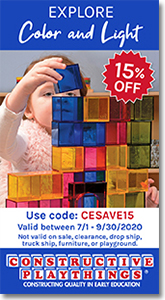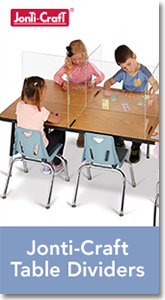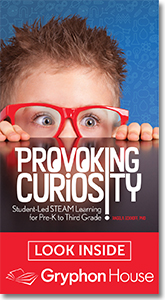ExchangeEveryDay Past Issues
 << Previous Issue
| View Past Issues | | Next Issue >>
<< Previous Issue
| View Past Issues | | Next Issue >> -Mary Lou Cook
Janet E. Thompson and Ross A. Thompson, in the Exchange Essential article collection, “The Power of Nature to Nurture,” write: “Most people know intuitively that there is something magical about the experiences offered to children by the outdoors. We grew up hearing our parents and grandparents tell us stories about their childhood summers spent playing outside, interrupted only by a parent's call to come inside for dinner. It may have been a grandmother's accounts of life as a young child on an Iowa farm, exploring the fields, streams, and woods with her brothers and sisters. Or a father's nostalgic memories of summers spent tagging along with the neighborhood's ‘big kids’ and being allowed to enter into their suburban ‘kid culture’ of alleys and yards — building secret hideouts, collecting treasures, and making up their own games.
But we who advocate for children's greater access to rich outdoor experiences can no longer rely only on nostalgic anecdotes. Even our first-hand observations of the children in our care are not enough. Our 21st century society demands research to give credibility to our practices. We must be able to show a link between young children's connections with nature and their healthy development.”
At the 2019 National Association for the Education of Young children annual conference in Nashville, Tennessee, Dr. Samuel Dennis, Dr. Rod Diercks and Christine Kiewra presented a new research paper, Natural Outdoor Classrooms: A National Survey. The extensive research addresses what the Thompsons advocate by making the link between children’s regular time in natural outdoor classrooms and a multitude of developmental benefits.
In the popular book, Bringing the Outside In, Sandra Duncan and Jody Martin offer this invitation for enjoying nature’s nurturing artistry outdoors, and indoors as well:
“Andy Goldsworthy is a British artist and photographer [who] creates with materials he finds right beneath his feet or within an arm’s length: twigs, stones, mud, berries, moss, ferns, leaves, pinecones, and acorns. With these easily accessible and found materials, he constructs visual beauty from natural objects (i.e. sculptures, mosaic-type patterns) on the ocean shoreline…or by the side of a woodland path – existing for a moment in time until they are altered by animals, humans, or erased by natural process. Simple and ordinary natural objects become extraordinary under Goldsworthy’s enchanted touch and imagination. Give children inside opportunities to create land art just like Andy Goldsworthy. Simply find a small area in your classroom and declare it the Andy Goldsworthy studio.”
The authors suggest beginning by checking out some of Goldsworthy’s photo-picture books from your local library. Some of his titles include: Andy Goldsworthy: A Collaboration With Nature; Andy Goldsworthy: Rivers and Tides; Hand to Earth; Andy Goldsworthy Sculpture.
to get 30% off this title for a limited time |
|
Offer valid through June 4, 2021, at 11:59 pm Pacific Time. |






Comments (2)
Displaying All 2 CommentsCambridge, MA, United States
But we who advocate for children's greater access to rich outdoor experiences can no longer rely only on nostalgic anecdotes.
We do not have to go along with this. There are some things that are intuitively obvious. To just step on board with this idea lends insult to the power of intuitive observation. Which is after all the basis of decent teaching of the young child.
We loose a lot, more than many can imagine, by not understanding the power that is in our own awareness as we work with children. Please all you young teachers, engage in your own truth about children. Bring them outside. Let them play indoors if that is where you are. Watch what they learn all on their own. Document this.
This is vital to your health as a teacher as well as to the dynamism of the children you spend your days with.
CSBC
Denver, CO. , CO, United States
Isn't every child their own Andy Goldsworthy? Let's respect each child as a '"world renowned artist"!
Post a Comment